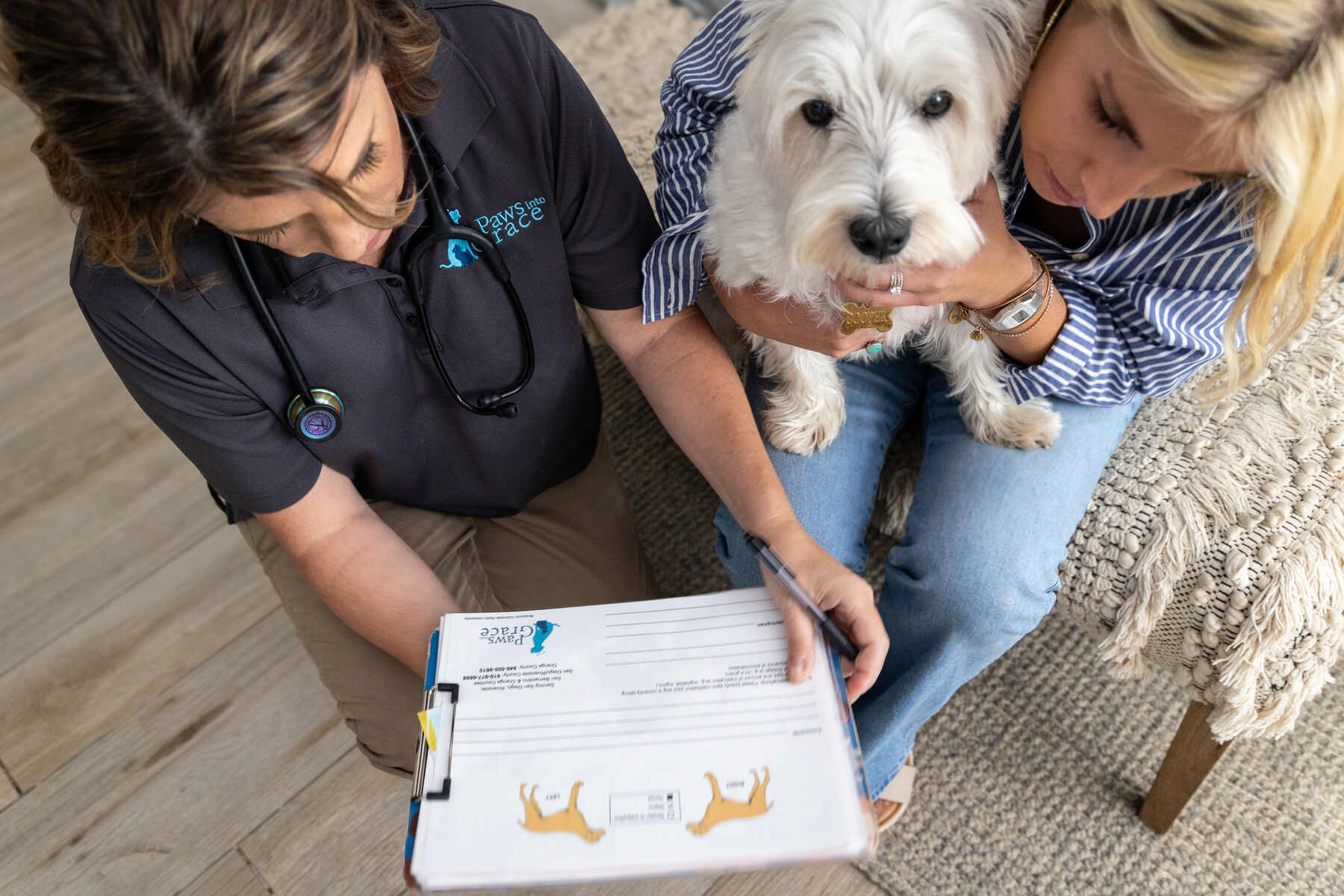Deciding when to say goodbye to your beloved dog suffering from Cushing’s is one of the hardest decisions pet parents face. Discover the signs that indicate when to euthanize a dog with Cushing’s disease to make the right decision for your pet dog’s life, and provide your faithful friend with the loving farewell they deserve.

When to Euthanize a Dog With Cushing’s Disease
Deciding when to euthanize dogs with Cushing’s disease is incredibly tough. It often comes down to when they’re experiencing unmanageable pain or their quality of life severely declines, even with treatment. If symptoms persist, complications arise, or the burden on the primary caregiver becomes too much, in-home pet euthanasia can be the kindest choice.
Eventually, you need to consider when it’s time to say goodbye to your dog and let them cross the rainbow bridge.
1. Unmanageable Pain or Discomfort
Cushing’s causes a dog’s body to become increasingly susceptible to secondary complications like urinary tract infections. This can cause significant pain that becomes difficult to manage. The constant cycle of pain and infections can severely compromise the dog’s comfort and well-being despite medical intervention.
2. Severe Decline in the Dog’s Quality of Life
Another consideration for pet euthanasia is when a dog’s quality of life has severely deteriorated. Cushing’s causes significant changes, such as an inability to move or disruptive neurological signs. When your pet dog can no longer find joy in daily activities and their days are filled with discomfort rather than contentment, euthanasia allows for a peaceful end.
3. Refractory Symptoms or Complications
When the pituitary gland continues to stimulate the adrenal glands to produce cortisol despite treatment, dogs may experience refractory symptoms like uncontrollable excessive drinking and urination. These persistent symptoms indicate that Cushing’s has become too advanced to manage effectively. This makes it reasonable to consider euthanasia when a dog’s suffering cannot be adequately controlled.
4. Caregiver Fatigue and Impact on the Family
The immense emotional and physical toll on a family from tirelessly caring for a dog whose body is failing due to Cushing’s, especially if left untreated, is a valid consideration for euthanasia. This includes the significant strain on time, energy, and finances. It also indicates that the burden has become unsustainable for ill pets and their human companions.
What Is Cushing’s Disease in Dogs?
Hyperadrenocorticism (HAC), also known as Cushing’s disease in pets, is a disorder in which excessive adrenal hormones are produced. It can be caused by abnormal pituitary gland function, adrenal gland or pituitary tumors, or high levels of doctor-prescribed steroid use.
These are the forms of Cushing’s disease:
- Typical Cushing’s: This form causes the adrenal glands to produce too much cortisol. The excess cortisol causes symptoms, like weight gain, high blood pressure, skin changes, and muscle weakness.
- Pituitary-dependent Cushing’s: This is when the pituitary gland overproduces the adrenocorticotropic hormone, resulting in fatigue, thinning skin, mood changes, and cognitive difficulties. Pituitary-dependent HAC accounts for about 80% of cases.
- Atypical Cushing’s: This is caused by an overproduction of adrenal steroid hormones other than the stress hormone cortisol, such as sex hormones. The effects manifest as classic Cushing’s symptoms, including skin issues and a pot-bellied appearance. This type of Cushing’s can sometimes resemble other conditions, such as sex hormone imbalances or hormone-secreting tumors.
Dog Breeds Prone to Cushing’s
These breeds are at a higher risk of getting Cushing’s:
- Dachshund
- Poodle
- Terriers in general
- Boxers
- Labrador Retriever
- Maltese
- Cocker Spaniel
- Bichon Frise
- Australian Shepherd
What Symptoms Can Present as Cushing’s Disease Progresses?
Knowing the symptoms of Cushing’s disease helps you identify worsening conditions. This enables you to make timely, informed decisions about treatment, pain management, and preparation for difficult end-of-life choices.
Mild Stage
The early-stage symptoms are primarily due to the catabolic effects of excess cortisol breaking down muscle protein. These can manifest in the form of:
- Progressive weakness of the hind limbs
- Worn nails
- Difficult rising
- Stumbling
- Knuckling of the toes
- Scuffing hind feet
- Wearing of the inner digits of the rear paws
- Loss of muscle in the rear legs
- Tremors of the rear legs
Moderate Stage
These symptoms of Cushing’s reflect the severe, widespread systemic damage caused by prolonged excessive cortisol. Dogs with late-stage symptoms can experience:
- Excessive drinking
- Persistent early signs
- Urinary and fecal incontinence
- Eventual front leg weakness from compensatory strain
- Mental stress/anxiety
- Pressure sores on bony prominences
- Inability to rise
- Muscle atrophy
- Poor hygiene-soiled appearance
- Pneumonia
- Depression
- Infection/sepsis
- Constipation
- Organ failure
Advanced Stage
These symptoms of advanced Cushing’s disease in dogs indicate life-threatening decompensation of a dog’s body systems, requiring immediate veterinary intervention.
- Difficulty breathing
- Prolonged seizures
- Uncontrollable vomiting/diarrhea
- Sudden collapse
- Profuse bleeding – internal or external
- Crying/whining from pain*
Note: Most animals will instinctively hide their pain. Vocalization that is out of the ordinary for your pet may indicate that their pain and anxiety have become too much for them to bear. If your pet vocalizes due to pain or anxiety, please consult with your vet immediately.
What Are the Common Signs of Pain Caused by Cushing’s Disease?
These signs of pain in dogs with Cushing’s disease come from excessive cortisol. They cause widespread systemic side effects that directly lead to physical discomfort and behavioral manifestations:
- Panting
- Lameness
- Difficulty sleeping
- Pacing
- Abnormal posture
- Body tensing
- Poor grooming habits
- Tucked tail
- Dilated pupils
- Licking sore spots
- Muscle atrophy
- Decreased appetite
- Vocalizing/yowling
- Reclusive behavior
- Aggressive behavior
- Avoiding stairs/jumping
- Depressed
- Unable to stand
How to Diagnose Cushing’s Disease?
Diagnosing Cushing’s disease in dogs requires a thorough approach to pinpoint the condition:
- The ACTH stimulation test is commonly used, but not the most sensitive for diagnosing Cushing’s. It’s better for confirming iatrogenic Cushing’s or monitoring treatment.
- The low-dose dexamethasone suppression test (LDDS) is often the preferred initial test because it’s more sensitive for detecting naturally occurring Cushing’s.
- Urine cortisol:creatinine ratio is useful as a screening test, but it has low specificity—meaning it can be falsely elevated due to stress or other illness.
- Ultrasound is helpful in distinguishing adrenal from pituitary-dependent Cushing’s, not necessarily confirming the diagnosis.
- Bloodwork and urinalysis do not confirm Cushing’s, but can support suspicion by revealing classic changes.
Treatment Options for Pituitary and Adrenal-Dependent Cushing’s Disease
Some animals respond to medical management alone, while others need both surgical and medical treatment. Control, rather than cure, is the outcome of treatment in most cases of HAC. These are the common medications used to treat Cushing’s in dogs:
- Vetoryl blocks cortisol production, making it the most common medication used for both pituitary- and adrenal-dependent Cushing’s.
- Lysodren specifically targets and reduces cortisol-producing cells in the adrenal glands.
- Selegiline suppresses the pituitary gland’s overproduction of ACTH.
If an adrenal tumor is the cause, surgical removal of the affected gland is an option. However, it’s a complex procedure that may only work on affected dogs depending on their current condition.
Prognosis for Cushing’s Disease
The long-term outlook for dogs with Cushing’s disease can vary. With consistent management and monitoring, many dogs live good-quality lives for months to years after diagnosis.
However, without treatment or if complications develop, some dogs may decline more quickly. In rare cases, if neurological issues such as degenerative myelopathy occur alongside Cushing’s, symptoms can progress and significantly impact mobility. Creating a personalized treatment plan with your veterinarian can help manage symptoms, support comfort, and maintain your dog’s quality of life for as long as possible.
Other Options If Treatment Is No Longer Working
When the quality of life of a dog with Cushing’s doesn’t improve and continues to deteriorate, hospice care or euthanasia should be considered.
Related Questions
What Are the Final Stages of Cushing’s Disease in Dogs?
The final stages of Cushing’s disease in dogs are marked by a severe decline in health, often characterized by pronounced muscle weakness and neurological decline. These stages may also include uncontrollable urination, excessive drinking, severe vomiting, diarrhea, and widespread secondary infections, severely compromising their quality of life.
How Do I Make My Dog Comfortable With Cushing’s Disease?
Despite having Cushing’s, your dog can become comfortable with the help of consistent medical therapy prescribed by your vet to manage hormone levels and alleviate symptoms. Provide soft bedding and easy access to food and water to improve their daily comfort.
Are Dogs Diagnosed With Cushing’s Always Hungry?
Dogs diagnosed with Cushing’s are often observed to have an increased appetite, which is a common symptom of the disease. This is due to the elevated cortisol levels impacting the brain’s appetite regulation centers.
What Happens When You Leave Cushing’s Untreated?
When Cushing’s is left untreated, the continuous excess cortisol production leads to severe and progressive complications affecting nearly every organ system. This can result in conditions like recurrent infections, fragile skin, neurological issues, and an increased risk of blood clot formation, eventually leading to organ failure and death.
Is Cushing’s the Same as Diabetes in Dogs?
Cushing’s isn’t the same as diabetes because Cushing’s is caused by pituitary tumors (or adrenal tumors) leading to an overproduction of cortisol, which impacts various bodily functions. Diabetes in dogs is caused by insufficient insulin production or improper insulin utilization, resulting in high blood sugar levels.
Conclusion
Knowing when to say goodbye to a beloved dog with Cushing’s disease is one of the hardest decisions you’ll face, but it can also bring peace. Choosing euthanasia at the right time allows you to honor their comfort, dignity, and quality of life. When that moment comes, Paws into Grace is here to offer compassionate guidance and support, helping you make this final decision with love and care.


